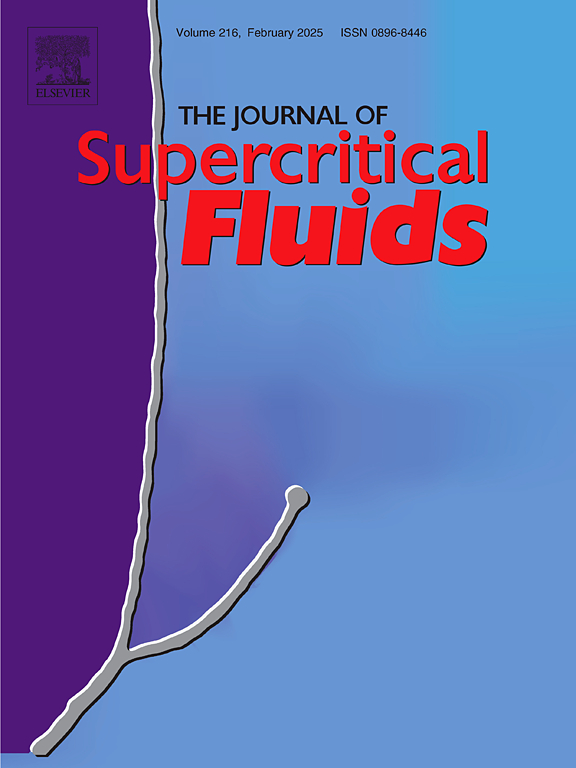白垩纪中高渗孔隙砂岩scCO2对流换热实验研究
IF 4.4
3区 工程技术
Q2 CHEMISTRY, PHYSICAL
引用次数: 0
摘要
在“两碳”目标背景下,大规模利用二氧化碳介质,特别是地热资源开发,对于减少不可再生资源消耗,促进绿色低碳未来至关重要。产生的热量可用于发电、储能、供热等,提高能源效率。超临界二氧化碳(scCO2)与多孔介质岩石之间的对流换热研究对于其在地热能和碳捕集领域的应用具有重要意义。在中深层地热研究的基础上,搭建了高温高压超临界流体和多孔介质流动换热试验台。对不同注射流速进行了实验比较和分析。结果表明,对流换热过程复杂,与流体和岩石性质、流速和温度梯度有关。在储层相关条件下,将孔隙尺度CT分析与高温高压实验相结合,发现白垩系砂岩胶结结构可使scCO2对流效率提高20 ~ 35 %。拟合Nusselt数曲线,分析断口表面局部对流换热。更高的流量可以使单位质量流量的热回收率更好,生产温度下降更快。岩石初始温度影响流体的出口温度和传热。提供了对scCO2扭曲流动动力学和方解石-胶结微观结构相互作用的新见解,提高了地热储层模拟的准确性。本文章由计算机程序翻译,如有差异,请以英文原文为准。
Experimental study on convective heat transfer of scCO2 with a middle-high permeability pore scale cretaceous sandstone
In the context of the two - carbon goal, the large - scale utilization of carbon dioxide medium, especially in geothermal resource development, is crucial for reducing non - renewable resource consumption and promoting a green - low - carbon future. The heat generated can be applied in power generation, energy storage, heating, etc., enhancing energy efficiency. Research on convective heat transfer between supercritical carbon dioxide (scCO2) and porous medium rocks is gaining importance for its applications in geothermal energy and carbon capture. Based on middle - deep geothermal research, a flow - heat - transfer test bed for high - temperature and high - pressure supercritical fluids and porous media was constructed. Different injection flow rates were experimentally compared and analyzed. Results show that the convective heat transfer is complex, related to fluid and rock properties, flow rate, and temperature gradient. Under reservoir-related conditions, combining pore-scale CT analysis with high-temperature and high-pressure experiments, it is found that the cemented structure of Cretaceous sandstone increases the convection efficiency of scCO2 by 20–35 %. Nusselt number curves were fitted, and local convective heat transfer on the fracture surface was analyzed. Higher flow rates lead to better heat recovery per unit mass flow rate and faster production temperature drops. Rock initial temperature impacts fluid exit temperature and heat transfer. Novel insights into scCO2 tortuous flow dynamics and calcite-cemented microstructure interactions are provided, advancing geothermal reservoir simulation accuracy.
求助全文
通过发布文献求助,成功后即可免费获取论文全文。
去求助
来源期刊

Journal of Supercritical Fluids
工程技术-工程:化工
CiteScore
7.60
自引率
10.30%
发文量
236
审稿时长
56 days
期刊介绍:
The Journal of Supercritical Fluids is an international journal devoted to the fundamental and applied aspects of supercritical fluids and processes. Its aim is to provide a focused platform for academic and industrial researchers to report their findings and to have ready access to the advances in this rapidly growing field. Its coverage is multidisciplinary and includes both basic and applied topics.
Thermodynamics and phase equilibria, reaction kinetics and rate processes, thermal and transport properties, and all topics related to processing such as separations (extraction, fractionation, purification, chromatography) nucleation and impregnation are within the scope. Accounts of specific engineering applications such as those encountered in food, fuel, natural products, minerals, pharmaceuticals and polymer industries are included. Topics related to high pressure equipment design, analytical techniques, sensors, and process control methodologies are also within the scope of the journal.
 求助内容:
求助内容: 应助结果提醒方式:
应助结果提醒方式:


